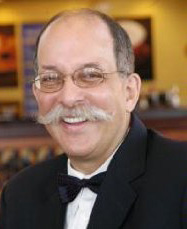
The Modern Butlers’ Journal volume 9, issue 8
International Institute of Modern Butlers
 Message from the Chairman
Message from the Chairman
A host told me recently that he had trouble trusting people—and it was evidently so, the way he vituperated (to disparage, blame another with use of strong language) against his neighbor. The same issue had come up a day earlier while consulting a client, who was having trouble with employees, vendors, even family members taking advantage of him. This question of knowing who to trust is central to all our lives, personal and on the job. “By their actions will you know them” is true enough advice, but do you really want your boss’ Italianate mansion repainted in gaudy neon pink six months behind schedule before you find out that you cannot trust the workman who came with such impeccable references and who yet seems to be both color blind and a bit too busy to see to your project?
Would it not help to know before you go?
Therein lies the trick, and I can heartily recommend you find out how to predict your fellow man before you go to much further down the road of life—at least, that is, if having a blood pressure that’s within range and things running smoothly are desirable goals.
Letters to the Editor
“For some time now, I have been very interested and have researched extensively the career of Butling. Could you kindly give me some perspective and any other insights you might have on beginning a career as a Butler? In addition, I would be interested in your endorsement of the profession based on the prospects—both current and future. I, of course, would not hold you responsible for any decision I make as a result of your opinion and advice. As the sage saying goes: ‘In a multitude of councillors there is wisdom.'” CS
Editor: To your quote I might add: “Seek your own counsel!” You know better than anyone else what would work for you, and hopefully, any information I add may assist you in making the correct decision. The first step would be to undergo training—whether at a bricks-and-mortar butler school or through a correspondence course, if funds and time are an issue.
But before you invest time and money in such training, I would suggest you try your hand at private service (or even hospitality or any other service industry as a second, less-useful option), especially if you do not already have such experience, to see if you really love the reality of such work. Without passion, neither you nor your future employers will really shine. Any work in private service will do, wherever you can interact with employers/clients in their homes/estates.
With passion and training in place, the next thing is a CV that supports your quest to become a butler. There are people who are already experienced as butlers and who would be more attractive to many employers, but not to all. You may have some advantage (such as a language that they need you to speak) that few others have. Or an ancillary skill, such as nursing, if they are geriatric and needing a butler/caregiver, etc.
In other words, I would not be put off by the competition when it comes to finding work, as your qualities properly marketed, and with persistence, will allow you to break into the profession. Also, with the numbers of wealthy set to rise over the next several years, the demand for butlers will increase, and this may result in anyone having no experience but at least a certificate, being much-prized.
***
I’d like to see if I can work part time as butler/assistant/driver, etc. for one or several families in my (remote) area. Do you have any suggestions on how one can enter the industry in such a capacity? I have had valuable experience working for two (high-standard) families in a city.
I know of one family here with a house manager. There is plenty of money here—it’s just hidden and not shown off. I could drop off business cards in the affluent areas. It’s possible I could volunteer at the local lieutenant governor’s mansion. (These are) a few different ideas I am considering. Any suggestions would be greatly appreciated. SE
Editor: Thanks for the update. Did you complete the butler course you had planned to do? If so, are they providing placement assistance? I believe that is meant to be part of the benefits of the course? Otherwise, have you contacted any other agencies? Your ideas are fine. You could add to them by doing the above, as well as advertizing in any upscale magazine and connecting with whatever existing Household Managers you can locate, to network.
Yes, I completed the course back in early 2011. I was then placed by their placement agency with a family. I have yet to contact them regarding positions in this area, as I remember them saying they have no contacts this far over. It’s a small and very underground market. SE
Editor: I suspect there are no domestic placement agencies in the area? Your plan to hand out your business card sounds like the best approach; maybe you could try and write, or be interviewed for, an article in the local paper, to put out the word and drum up interest from likely employers?
Butlers in the Media
“The Butler” movie is to be released on the 16th of this month, retitled Lee Daniel’s The Butler to avoid a conflict with an earlier short movie of the same title. Within a long article published recently in the Washington Post, is a short snippet from one of the lead actors, Forrest Whitaker, on researching the role.
A happy travel-writer from the Huffington Post croons over the butlers in her hotel.
An unfortunate noise from down-under emanating from politicians who should know better, about whether standard secretarial service in setting up conference rooms for use, is really butler service paid for reprehensibly by public funds—just another angle on our profession. A more accurate or pertinent one concerns the rise of the profession, especially in the Middle and Far East.
Talking of which, a culture shock between the Middle East and the West: a Saudi princess finds herself in jail for allegedly treating her staff in Los Angeles—in violation of a recent change in Californian law concerning human trafficking—in the same way she does, no doubt, without repercussion in her home country. Plenty of room for improvement in perceptions and considerations about private-service staff deserving treatment as human beings, rather than serfs.
Consulting the Silver Expert
Mr. Jeffrey Herman continues to offer his services to our readers, for any questions you may have about the care of silver. Either call him at (800) 339-0417 (in the USA) or email jeff at hermansilver.com.
Q: What are the rough spots on my sterling that I cannot remove with silver polish?
A: Those black rough spots you feel on sterling (or other solid silver alloys) which cannot be removed with silver polish are most likely corrosion. Place an ammonia-soaked cotton ball on the corrosion spot and it should dissolve within ten minutes. If not, repeat for ten minutes at a time until the corrosion has gone. You may need to use some silver polish on a Q-tip or cotton ball and “massage” the area very lightly until you bring up the shine to blend in with the surrounding area. There will probably be a shallow etched spot that remains under the corroded area.
Placement
Household Manager sought by a senior couple in a 5,000 sq. ft. residence in Houston, Texas. The job requires standard household management functions as well as some cooking, covering for the housekeeper during her off days, and some driving. Good remuneration package, with salary DOE and your expectations; can be live-in or live-out. Interested candidates should contact the Institute via enquiries at modernbutlers.com with current resume, salary requirements and a good quality current photograph, preferably a full-length shot.
 Cigars, Part XVII
Cigars, Part XVII
by Frank Mitchell
Serving a Cigar, Part 2 of 2
The guest most likely to accept your offer to cut and light is probably a novice and may be hoping to pick up some tips. Make sure they can see what you are doing and be ready with an explanation. I have taught several guests how to cut and light a cigar and they are always immensely grateful. When you are cutting and lighting, you should use whichever cutter you are most comfortable with, provided it is suitable for that shape of cigar.
Cut a hole large enough to ensure a good draw, but leave a ring of cap intact, otherwise the cigar will fall apart. A rough guide is to cut halfway up the height of the cap, but this will depend on the size and shape of the cigar. There are several videos online that help explain this, but cutting and smoking a few cigars for yourself will be the best way to understand what you need to do.
When lighting a cigar, hold the cigar at a 45° angle to the floor and rotate it longitudinally between the thumb and forefinger as you toast the foot with the heat of the lighter. Do not push the foot into the flame to rush the process. This will only char the wrapper. Move the flame about so that it heats the foot evenly. When you decide the lit end needs some air on it, do not blow on the cigar! You may move the cigar through the air, but be very careful not to stab someone with the hot end! Reapply the flame before offering the cigar to the guest. By this time, they will have figured out what you are doing and may ask for the lighter to finish the job themselves.
In my experience, guests may occasionally pocket your cutter or lighter in the absent-minded repetition of a habitual motion. If the cigar paraphernalia belongs to the hotel, your policy may simply be to add it to the bill and keep some spares on hand. The guest may decide to keep them after all, or may prefer to return them and have the item removed from the bill. If it is a really good guest who spends a great deal of money at your establishment, it may be wise to simply write it off as an expense. If the paraphernalia are your private possession, be tactful. It is helpful to remember that pocketing a lighter after using it is an action which a smoker has practiced to the point of it being a reflex. You learn to watch for it and as the hand moves towards the pocket say “Thank you, sir,” while extending the salver: Problem solved.
Next month we will look at some of the more traditional (and perhaps showy) methods of lighting a cigar.
 Let’s Talk about Wine, Part XVII
Let’s Talk about Wine, Part XVII
by Amer Vargas
This month we are in the beautiful country of Uruguay. The smallest in South America, it is located on the Atlantic coast of the continent and borders on Brazil to the North and Argentina to the West. With the latter, it shares a latitude that allows for wine growing (it shares that same latitude also with the great wine-growing regions of Chile, South Africa, and Australia).
Indeed, Uruguay is a privileged land when it comes to the right geography for cultivating wine producing grapes: vitis vinifera is cultivated in 16 of the 19 “departments” (similar to provinces) in the country; 90% of these are located in its more southern region.

Uruguay is a fairly flat country and enjoys the benefits of a temperate, maritime climate, with sunny and dry summers, cold and humid autumns and winters, and average yearly temperatures of 18 0C/64.5 0F. Soils vary from dry and rocky in the north to rich in limestone and clay in the south, all of which allows for the production of a large variety of wine styles and grapes.
Wine production in Uruguay dates back more than 250 years. However, the arrival in 1870 of the Basque, Don Pascual Harriague, who brought with him the Tannat grape from southern France, provided the breakthrough the country needed to start appearing on the world map of best wines. Since then, and especially after the so-called Mercosur Agreement (an economic-commercial agreement between South American countries) in 1980, Uruguay has striven to increase the quality of its wines so as to be able to compete in the same markets as Argentina and Chile.
The Tannat grape is Uruguay’s signature grape, making up 36% of the total cultivated grapes. Other important grapes, in order of cultivated quantities, are Merlot, Chardonnay, Cabernet Sauvignon, Sauvignon Blanc and Cabernet Franc. Thus, most wine production in Uruguay is devoted to the creation of rich and medium-to-full-bodied red wines, although some of their white wines will please the most demanding of palates.
Don’t hesitate to pair the excellent Tannat with red meats, especially if grilled—simply a perfect pairing.
Cheers!
The Institute is dedicated to raising service standards by broadly disseminating the mindset and skills of that time-honored, quintessential service provider, the British Butler, adapted to the needs of modern employers and guests in staffed homes, luxury hotels, resort, spas, retirement communities, jets, yachts, & cruise ships around the world.


